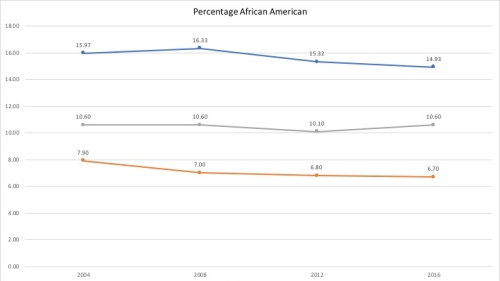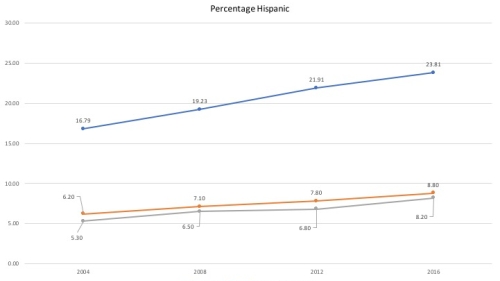Diversity matters for student learning. Representation matters. It is a difficult task to identify anyone working within the education ecosystem—whether they be a teacher, school leader, policymaker, researcher, or advocate—without a strong stance on these claims. Ever since the Supreme Court concluded that integration is in children’s best interest for educational progress, there have been many ongoing attempts to support (and undermine) racial/ethnic diversification within schools and classrooms.

The displayed year represents the lagging school year (e.g., “2004” refers to 2003-2004 school year). Teacher and principal percentages based on estimates from the Schools and Staffing Survey (SASS) for 2004 through 2012 and the National Teacher and Principal Survey (NTPS) for 2016. Student percentages based on computations from the Common Core of Data (CCD). The terms “African American” and “Hispanic” are used in place of “Black” and “Latinx” to reflect terminology used directly in the SASS and NTPS survey instruments.
However, diversity among educators has become a focal public interest as well. The interest here primarily arises due to the historically dire underrepresentation of black and brown practitioners and leaders within classrooms and schools. The numbers present a startling piece of reality. For example, national estimates suggest that while African American students comprised about 15 percent of the student population in public schools in 2016, only about 7 percent of teachers and 11 percent of principals were African American in that same year. The representation gap is even worse among Hispanics and has remained static over the past decade.

The displayed year represents the lagging school year (e.g., “2004” refers to 2003-2004 school year). Teacher and principal percentages based on estimates from the Schools and Staffing Survey (SASS) for 2004 through 2012 and the National Teacher and Principal Survey (NTPS) for 2016. Student percentages based on computations from the Common Core of Data (CCD). The terms “African American” and “Hispanic” are used in place of “Black” and “Latinx” to reflect terminology used directly in the SASS and NTPS survey instruments.
There is a large body of research detailing the benefits of diversity among educators for students, which have recurrently focused on how shared cultural experiences support meaningful mentorship relationships and mitigate stereotype threat. In recent years, multiple studies using a variety of nationally representative samples and data from several states and districts have indicated that racial representation of teachers within classrooms influences students’ social-emotional development, performance on standardized tests, disciplinary outcomes, and high school graduation rates among students of color. So far, the consensus from the available research is clear: representation matters for students of color.
But we still have more to learn.
First, contemporary quantitative studies in this area place a heavy emphasis on student-teacher “race-matching” by focusing on the effects of having students of color exposed to teachers of color within the classroom. While these are doubtless important effects to understand, what occurs as a results is that research largely overlooks how the presence of racial/ethnic minority teachers may have broader organizational and cultural effects on schools. We still have more to learn about whether and how diversity among teachers and education leaders authentically transforms school administrative policies and instructional practices, enhances trust and cohesion among staff, and increases teacher retention and satisfaction.
Even more important is committing to long-term solutions that can systematically improve the pipeline for educators of color within the public school system. The U.S. Department of Education, national teachers’ unions, and non-profit organizations have continually voiced a concern for the lack of diversity among teachers. The need to empower teachers and principals through effective preparation, compensation, and leadership opportunities to assure that educators of color are systematically attracted to and retained within the field is an area worth exploring if we are ever to create and sustain an educator workforce capable of serving all students.
About the Author: Luis A. Rodriguez is Assistant Professor of Education Leadership in the Department of Administration, Leadership, and Technology at NYU. His research focuses on evaluating the effects of education policy reforms on the K-12 teacher workforce and is particularly interested in identifying programs and practices capable of sustaining an equitable distribution of diverse and highly qualified teachers.

